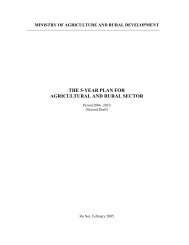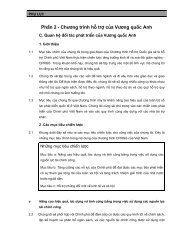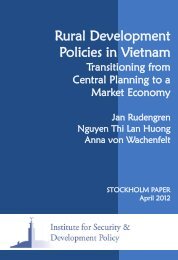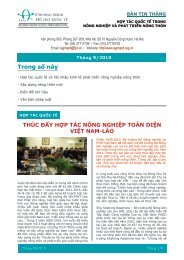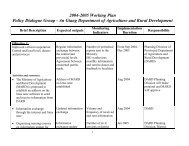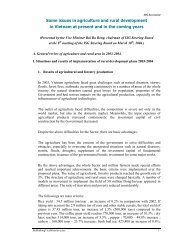Income Diversification and Poverty Income Diversification and Poverty
Income Diversification and Poverty Income Diversification and Poverty
Income Diversification and Poverty Income Diversification and Poverty
You also want an ePaper? Increase the reach of your titles
YUMPU automatically turns print PDFs into web optimized ePapers that Google loves.
Chapter 2. Background on the Northern Upl<strong>and</strong>s region<br />
income. At the national level, this is equivalent to structural transformation, defined as the long-term<br />
decline in the percentage contribution of agriculture sector to gross domestic product (GDP) <strong>and</strong><br />
employment in growing economies. For example, the contribution of agriculture to GDP in Vietnam<br />
has declined from 35.3 percent in 1991 to 24.1 percent in 1995 <strong>and</strong> 19.9 percent in 2000 (GSO, 1997;<br />
Ministry of Agriculture <strong>and</strong> Rural Development, 2002).<br />
Alternatively, agricultural diversification can be defined as the shift from crop production to<br />
livestock, fisheries, <strong>and</strong> forestry activities. Similarly, crop diversification refers more narrowly on<br />
shifts in the composition of crops grown. In contrast to non-farm diversification, crop diversification<br />
(defined in terms of the number of crops) is often greatest among poor subsistence farmers in rainfed<br />
agriculture. The reasons for this pattern are discussed below.<br />
2.1.2 Determinants of diversification<br />
Given the well-known gains associated with specialization, why do rural households in<br />
developing countries adopt multiple income-generating activities At least six factors can be<br />
identified:<br />
• First, multiple income sources can be a strategy to reduce risk. If each source of income<br />
fluctuates from year to year due to weather or other factors <strong>and</strong> the variations in income<br />
are not positively correlated across sources, then a household with multiple income<br />
sources will experience less income variability than a specialized household. Risk<br />
management may help explain crop diversification because some crops (such as cassava)<br />
are more drought tolerant 1 than others. In addition, risk management helps explain<br />
diversification from crop production into non-farm activities such as wage labor <strong>and</strong> nonfarm<br />
enterprises. When diversification is motivated by risk management, the household<br />
generally has to sacrifice in terms of average income. Thus, we expect diversification to<br />
occur when income sources are highly variable <strong>and</strong> when households are particularly risk<br />
averse. This is consistent with empirical research that shows that poor rural households<br />
practicing rain-fed agriculture in low-potential areas are more likely to have diverse<br />
income sources than richer households in areas with greater agro-ecological potential.<br />
• The second motivation for diversification is that there may be positive externalities<br />
between different activities so that total income from combining two activities is greater<br />
than if the household specialized in either one. For example, livestock production<br />
provides animal traction <strong>and</strong> manure which increase the productivity of crop production.<br />
Alternatively, crop production <strong>and</strong> agricultural processing may be more efficient when<br />
carried out by the same household if it reduces transportation costs.<br />
• Third, multiple income sources may be useful as an adaptation to missing or poorlyfunctioning<br />
markets. For example, if a household has plot of l<strong>and</strong> that is too small to fully<br />
occupy family labor, one option would be to rent or purchase additional l<strong>and</strong>. But if l<strong>and</strong><br />
markets do not exist, then the household may be forced to use its “surplus” labor in nonfarm<br />
enterprises or wage labor even if the return is lower. Alternatively, if credit markets<br />
do not operate efficiently <strong>and</strong> a household has a cash constraint, it may use non-farm<br />
activities to earn cash to pay for agricultural inputs.<br />
1 On the other h<strong>and</strong>, Quiroz <strong>and</strong> Valdez (1995) argue that crop diversification is unlikely to reduce<br />
income risk because the yields of different crops are closely correlated since they are both affected by weather.<br />
Page 10







